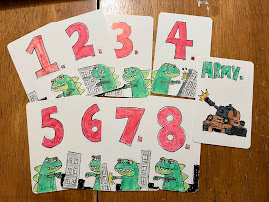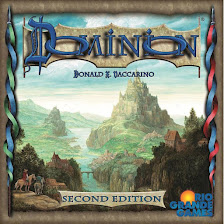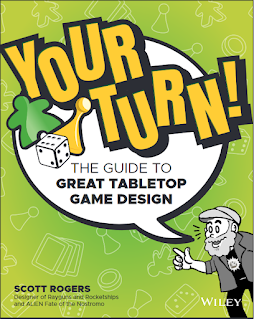13 GAMES EVERY GAME DESIGNER MUST PLAY*
The internet is filled with lists about the best games that every game designers MUST play, however I find them to often be a bit arbitrary and directionless.
Why do game designers NEED to play these games? What are they learning from each of these games? I was interested in creating a list of games that better represent the game genres that some others lists I've read about.
Dominion : Even though it's the first ever game of the deck building genre, it's still holds up. It's simplicity makes it the clearest example of the genre. While there are other good deck-builders out there (Star Realms, Arkham Horror: The Card Game, Century: Spice Road) These newer game designs have added roles, and attributes and other mechanisms that I feel just complicate things. As deck building is a flexible mechanism that can be added to many game designs, I believe it's better to start with understanding it completely, before integrating it in other designs. If you are looking to learn the basics of deck building, this is the game to play.

Sushi Go: Whenever some one asks me what "drafting" is, I ask them "Have you played Sushi Go? That's drafting." Sushi Go is so simple, so elegant but with so many ways to score, it's the perfect starting point to learn how to make a drafting game. Drafting, like deck building, is a mechanism that can be added into almost any game, especially when it comes to fairly distributing cards, and it helps to have a clear example when first learning the mechanism.
Skull King: I didn't grow up playing "folksier" card games like hearts, spades and rummy, so for many years, I wasn't sure what "trick taking" was. Skull King was the first game I played where it really clicked for me. It helped that it's pirate themed (I like pirates!) but Skull King made the trick-taking mechanism really clear to me and inspired me to design my own trick-takers!
Can't Stop: While there are plenty of great "push your luck" games out there - Farkle, Incan Gold, Dead Man's Draw, King of Tokyo, Zombie Dice - I feel that dice offers the best expression of the mechanism and adds much to the tension and fun of a push-your-luck game. Can't Stop lives up to its name; it's simple to learn and play, highly addictive and lends itself to quick and repeat games. Plus, it was designed by Sid Sackson, the great collector, designer and academic of the gaming industry.
Qwixx: While there are plenty of good roll and write games out there (Yahtzee, Cartographers, Three Sisters) I find that Qwixx does something different (and better) than these other games - the use of colored dice in the game was eye-opening to me when I first played the game. It's a great lesson on how a simple element of a component - such as its color - can make a huge different to the play of the game. On top of that, Qwixx has great decision making conundrums that creates great tension in the game! I highly recommend checking it out!
Unearth: Whenever anyone asks me "what's a hidden gem game" I always point them to Unearth. It has the best use of polyhedron dice since D&D (OK, maybe since Formula D) that utilizes a mix of dice selection and push your luck in a very creative manner. Add a couple of splashes of set collection and a bit of art inspiration from the mobile game Monument Valley and Unearth is a very appealing game. Unearth has a lot of great lessons to teach game designers - from probability space to how players can mitigate randomness - and is well worth your time to play.

Stone Age: One of the first worker placement games, Stone Age is just simple enough for newbies to learn and complicated enough to be enjoyed over and over again. It's a great game for learning the basics of worker placement. While others might suggest Carcassone (workers don't generate anything), Agricola (too complicated) or Lords of Waterdeep (too many side distractions) as paragons of worker placement, I think Stone Age is the epitome of worker placement. Place a piece, they collect a resource, they come back home to be used again. Plus you have the "love hut" - a location where a player places two meeples and on the next turn a third is generated. It's little touches like that that keeps Stone Age on the list.
Karuba: When describing Karuba, I ask "Do you like Indiana Jones? Do you like Bingo? That's Karuba!" Another "hidden gem" this tile placement offers a great lesson - players can start with completely identical components and rules and still manage to create very different results. The game offers great tension and much like Qwixx, if you screw up, it's your own darn fault.
Pandemic: Matt Leacock obviously had one of those "touched by God" moments when he came up with Pandemic. It's one of those perfect games - cooperative play but players have asymmetrical powers, the tension ratchets up as player race around the world trying to stop the spread, the viral spread of the contagions is such a clear and frightening visual of how quickly and bad things are getting in the game. The card AI is a great invention, automating the threat so the players can concentrate on stopping it. Plus, like all great games, Pandemic lends itself well to reinterpretation - whether it's World of Warcraft, Lord of the Rings, Cthulhu or the post-apocalyptic legacy versions, Pandemic is a great game that offers many lessons to a designer.
Quacks of Quedlinburg: I know, it's called "Quacks" now, but it will always be Quacks of Quedlinburg to me. No matter what you call it, this push your luck/asymmetrical powers is a great example of the ever increasingly popular bag-builder mechanism. It's clear, clean and fast paced game play has some clever catch up mechanisms so that no player feels like they're being punished too harshly by a bad draw. I've upgraded my own copy of the game to resin tokens and I can tell you, they make a huge difference to the game. The pleasures of a good tactile experience should never be overlooked.
Risk Legacy: Risk is pretty old, but Risk legacy added a much needed shot in the arm to the classic "dudes on a map" game play. Risk's combat system is still a good lesson in simplicity over realism, but where Legacy shines is how it adds much-needed narrative, surprise and twists to what is a pretty pedestrian game. Even better, the Legacy system adds a sense of repeatability and ownership that is missing from most other board games. While there have been many worthy successors to Risk Legacy (Including Betrayal Legacy, Charter stone and Pandemic Legacy) the original is still worth playing for the thrills and surprises it offers. And watching your fellow players cringe as they tear up cards never gets old.
Betrayal at House on the Hill: I first learned about this game when someone told me that it has fifty different endings. Fifty endings? How can that be? It seemed impossible, like a magic trick. This mechanic is worth study alone. It's still one of the best thematic games out there, but I'm a sucker for games with miniatures, modular board design and dice, and Betrayal pushes all of these buttons for me. I have witnessed near-perfect synchronicity between the location tiles and the room cards more times than I thought could be possible. The "haunt roll" remains one of my favorite thematic mechanisms in board gaming. You know doom is coming, it's not a matter of "if" but a matter of "when". I personally recommend the 1st and 3rd editions of the game, over the 2nd or any of it's expansions. Sure, any version of Betrayal's play can be a bit fiddly as you search for that little girl token, but believe me, light some candles, dim the lights and you'll find it's worth the experience.
Colt Express: If you want to learn how to design a programming card game, then look no further than Colt Express. The game teaches an important lesson - that you have to embrace the chaos of the programming game genre to enjoy it. But where Colt Express shines over games like Robo Rally or Dungeon Lords or Gloomhaven is table presence. That paper craft train is so charming, yet so pivotal to game play. Does it need paper craft cactus too? Probably not, but I think it'd be worse off without them.
Quiddler: Game number 13 on these kinds of lists are always hard to pick. Do I select a party game like Cards Against Humanity or Werewolf? Or an economic game like Acquire or For Sale? I feel that word games are a segment of the game design world that has had some interesting strides and is always evolving. But Quiddler shines in it's simplicity. It's essentially an escalating Scrabble without a board, but it's a great lesson in hand-size, alternate scoring and just how many turns does it take for someone to spell a word (usually it happens in 1-3 turns). It's gotten me to look at what comprises a "simple" card game design in a new light and it might help you too!
That was fun! I think I could probably list 13 more games (and I might in the future!) Let me know if you enjoyed this post!
If you want more suggestions for great games, I recommend checking out my book "Your Turn! The Guide to Great Tabletop Game Design" - not only are there lists of "ten games of this genre you must play" in each chapter but also many ideas for mechanisms and examples of games that you can make yourself! Your tabletop game design journey starts here!
*Thanks to Chris Backe who inspired me to write my own list!





































